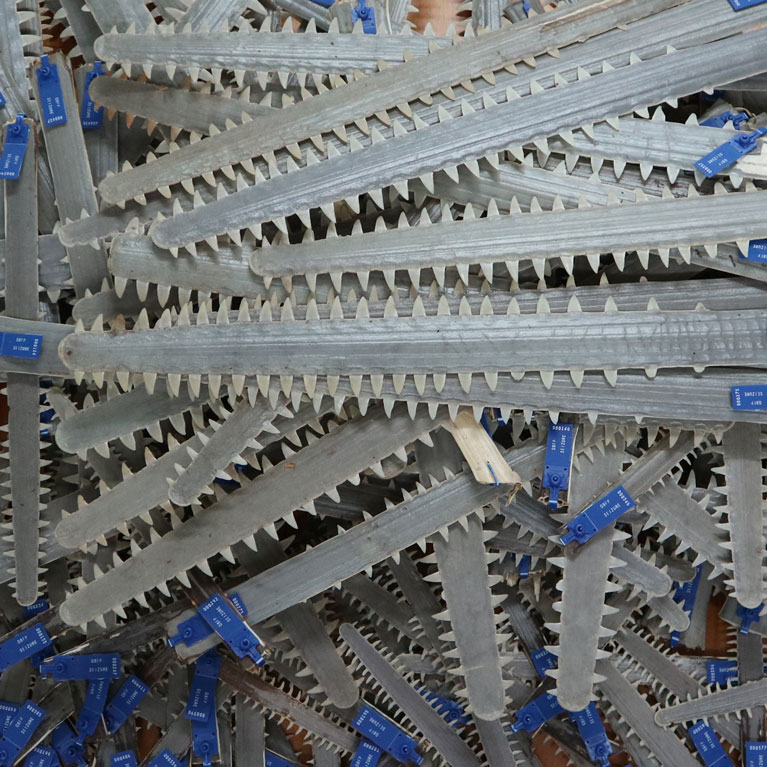The tooth about Australia’s sawfish hotspots
Veronika is innovating microchemical analysis on the teeth from confiscated sawfish rostra to trace the animals’ movement patterns throughout their life. As a lifeboat for remaining sawfish, Australia is a key player in their conservation. But while the incentive remains to trade valuable fins and rostra, there is under-reporting in commercial fisheries that has led to issues in the estimates of sawfish distribution and abundance. Without accurate information about which habitats are critical at different life stages, sawfish are left vulnerable when management measures cannot be guided and informed. Veronika will use the information laid down in sawfish teeth to identify hotspots and generate a risk map to improve conservation management.
Since I grew up in California and Hawaii, it probably isn’t surprising to hear that I always felt most at home near the ocean. At a young age I became a certified diver and family vacations were planned around predicted visibility and the movements of pelagic species. After completing my Master’s degree in medical sciences at Boston University School of Medicine, I moved back to the coast, splitting my time between volunteering in vertebrate fossil curation at the San Diego Natural History Museum and working as a teacher. Ever determined to get back into the water, I took...
A novel approach to identifying sawfish rostra origin to fill knowledge gaps in distribution
The key aim of this project is to use the chemical fingerprint from sawfish rostral teeth to gain new insights into their spatial ecology.
Sawfish are protected in Australia at national, state and local levels, but they are still at risk due to bycatch and demand for fins and rostra. Under-reporting in commercial fisheries leaves a massive blind spot in estimates of their distribution and abundance, making tangible management strategies impossible to implement. In addition, because remaining populations are so fragmented, encounters are rare within extremely large areas, so other analytical tools are required to complement field-work efforts.
Once an icon found across tropical habitats worldwide, sawfish are disappearing faster than appropriate management measures can be put in place. Northern Australia is termed a ‘lifeboat’ for sawfish, in part due to greater protection there than elsewhere in the world. However, there is still incentive for fishers to retain sawfish, as both fins and tooth-studded rostra are highly valued.
These trophy rostra may hold the key to sawfish conservation. Morphometric studies have produced models that enable researchers to estimate the total length of a sawfish from its rostrum. Paired with detailed location information, this helps us to determine areas that are critical habitat for various life-history stages. From this, we can identify populations at highest risk from fishing pressure and assess the level of recovery following state-wide protection. While trophy rostra are widely available, they typically lack fine-scale location details, rendering them unsuitable for spatial analyses.
Microchemical analysis, however, can generate new ecological data from hard-part structures, including rostral teeth. Like other cartilaginous fish, the sawfish skeleton is mineralised by calcium accumulated through the diet, with other metals accrued in trace amounts relative to the surrounding environment. These structures are not reworked over the sawfish’s lifetime and therefore hold a permanent record of their life history. This chemical fingerprint has been identified through induction coupled plasma mass spectroscopy (ICP-MS) and used to pinpoint origin with high accuracy for other species. For sawfish, where current research is almost entirely based on juveniles, this analysis has the potential to capture the movements of adults, a rare opportunity in Australia.
The aim of this project is to use microchemical analysis (ICP-MS) on teeth from confiscated sawfish rostra
- to identify sawfish population hotspots that are vulnerable to ongoing recreational and commercial fishing pressure;
- to generate a risk map that will contribute directly to conservation management.


